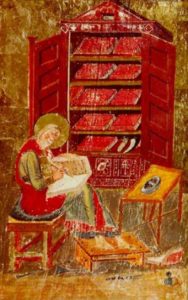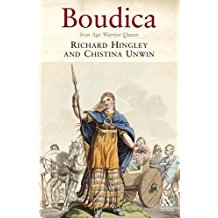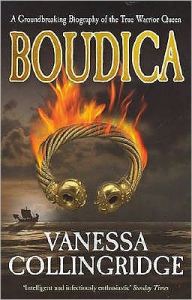Boudica, Queen of the Iceni:
Two books
 We authors—especially of historical fiction—cannot get along without our research books. (We also like to visit the places we write about, explore museum exhibits, and participate in archaeology and reenactments, but this post will talk about research of the armchair variety.) We prefer primary sources: journals, diaries, letters, histories, account lists, and literature written in the period, describing the people and events we want to write about; but that’s not always possible. For cultures that didn’t have a written language (the Iron Age Celts), or it was indecipherable (Egyptian hieroglyphs until the discovery of the Rosetta stone), or it was destroyed (Mayan books burned by conquering Spaniards); we have to rely on secondary sources. Books, essays, and articles by academics and other professionals in their fields are the best we can do for written research in such cases. But we have to be careful even with those. Just as in evaluating primary sources we have to keep in mind the biases and knowledge of the writer, we have to do the same with secondary sources. Let’s face it, there’s a lot of dreck out there—particularly on the internet—and historical fiction authors usually like to get as close to the truth as possible.
We authors—especially of historical fiction—cannot get along without our research books. (We also like to visit the places we write about, explore museum exhibits, and participate in archaeology and reenactments, but this post will talk about research of the armchair variety.) We prefer primary sources: journals, diaries, letters, histories, account lists, and literature written in the period, describing the people and events we want to write about; but that’s not always possible. For cultures that didn’t have a written language (the Iron Age Celts), or it was indecipherable (Egyptian hieroglyphs until the discovery of the Rosetta stone), or it was destroyed (Mayan books burned by conquering Spaniards); we have to rely on secondary sources. Books, essays, and articles by academics and other professionals in their fields are the best we can do for written research in such cases. But we have to be careful even with those. Just as in evaluating primary sources we have to keep in mind the biases and knowledge of the writer, we have to do the same with secondary sources. Let’s face it, there’s a lot of dreck out there—particularly on the internet—and historical fiction authors usually like to get as close to the truth as possible.
In researching Sword of the Gladiatix, I collected several books, articles, and pamphlets on Boudica and Roman Britain, most of an academic nature, a few of the more “popular” variety. The two biographies of Boudica I review below are the best by far of both types. You can read either or both and get a well-researched, readable history of the Iceni Queen, her times, and her legacy in popular culture. Which to read depends on your needs and nature.
The Academic Biography
The Details:
- Title: Boudica: Iron Age Warrior Queen
- Authors: Richard Hingley and Christina Unwin
- Publisher: Bloomsbury Academic; (August 21, 2006)
- ISBN-10: 1852855169
- ISBN-13: 978-1852855161
- Format: Trade paperback, 256 pages, (prices vary)
From the Introduction:
The detail provided by the two classical authors does not mean, however, that we actually know very much about her [Boudica]. The Roman accounts were written by wealthy and powerful men who lived at the Mediterranean core of the Roman Empire and who had certainly never met her nor even visited Britain. They also wrote some time after the end of the events that they described. For these two writers, the tale of Boudica was useful because it provided a moral story for their intended audiences.”
As I said in my earlier essay on the mythologizing of Boudica, we actually know very little about her. What we do know, what we don’t, and what we think we know but should take with a grain of salt; Hingley and Unwin lay out in their excellent book Boudica: Iron Age Warrior Queen. Both authors are archaeologists and their academic credentials show (Richard Hingley also lectures in Roman Archaeology at Durham University). They meticulously review the primary sources, the archaeology, and legends that have built up about Boudica in an articulate and readable narrative. The authors also provide numerous maps; illustrations; and pictures of coins, artifacts, and art. As with any good academic book, it is liberally sprinkled with footnotes and ends with an extensive reference section and index.
In “Part One: Boudica,” they give an overview of Iron Age and Roman Britain, deconstruct the classical sources of Tacitus and Dio, and review all the most recent archaeological evidence (including coins, burials, and the destruction layers of the burned towns) relating to Boudica’s rebellion. These hundred or so pages are all anyone has to read to have a great overview of what we know—and don’t—of Boudica’s life and times. In “Part Two: Boadicea,” they take on the myth of Boudica as it came down to us from Medieval times to today, showing us how the Iceni Warrior Queen has become the “Woman of Many Faces” and icon to groups of all kinds from nationalists to feminists. For the writer/researcher, this is the best book I’ve run across on the subject of Boudica: factual, well-researched and annotated. But it also works for the casual reader as entertaining biography, history, and sociology. Highly recommended for all comers.
The Popular Biography
The Details:
- Title: Boudica
- Authors: Vanessa Collingridge
- Format: Trade paperback, 402 pages, $11.25
- Publisher: Crown Publishing Group (April 28, 2006)
- ISBN-13: 978-0091898205
- Format: Kindle, 1383 KB, $11.84
- Publisher: Overlook Books, (June 26, 2007)
- ASIN: B009BJUSQC
Collingridge, according to her LinkedIn profile, is an award-winning broadcaster, journalist and writer specializing in science, history and the environment. Her work has appeared on all major TV and Radio channels in the UK, along with Discovery, The History Channel, ABC, PBS, TVNZ, RTHK, BBC World Service and The Learning Channel worldwide. Her bias toward popularizing history shows in her take on the Boudica story. In this book, she is an adoring fan on an adventure to discover the source of her hero worship and takes us along on a fascinating journey. Collingridge covers much the same ground as Hingley and Unwin (she interviews and quotes Hingley) but in a totally different style.
From Chapter 9: The Outrage Against Boudica:
By now, my search for Boudica had led me across the UK and Europe, through many hundreds of books and papers, and scores of interviews—but finally I had arrived at the woman herself…Like a child letting go of a favorite blanket, it was time to leave behind our old school histories, our emotional connection with this icon from the past and the cultural confusion that credited the Romans with bringing us civilization—yet made their enemy a national heroine. One thing had become all too clear: the Boudica story is as much about us as about an Iron Age warrior queen.”
As you can see from the quote above she doesn’t get to the heart of the Boudica story until page 183. She spends the first half of her book exploring Roman and Iron Age Celtic culture, comparing and contrasting their history, religious rituals, attitudes toward women, and much more before delving into the Boudica story as told by Tacitus and Dio. She covers this story in the next eighty pages, weaving literary analysis and current archaeology in with her vividly imagined descriptions of destruction by both Romans and Iceni. The rest of the book is devoted to her own interesting analysis of Boudica’s impact on British cultural history from Milton to Margaret Thatcher.
Readers of all kinds will find Collingridge’s book entertaining and, at the core, factual. Writers/researchers looking for “notes” will find it a rough go because of the imagined descriptive style and lack of annotation (although she does provide a select bibliography and extensive index). I enjoyed it for the psychology and sociology and recommend it to those who like a bit of theatrics with their history—or want to avoid footnotes!
In conclusion, I enjoyed and will recommend both books, but found Boudica: Iron Age Warrior Queen the superior book for researchers. What’s your favorite book (fiction or non) about Boudica? Give your favorite authors a shout out in the comments. Enjoy!


